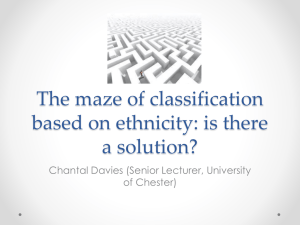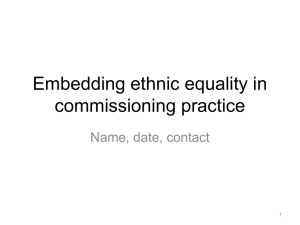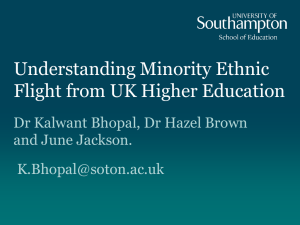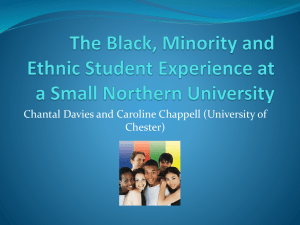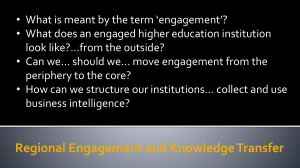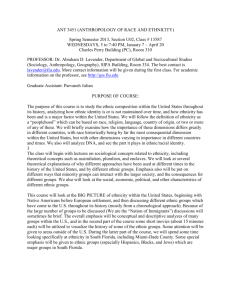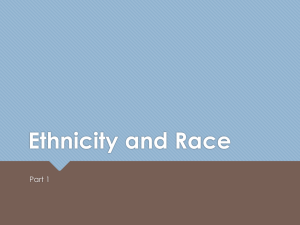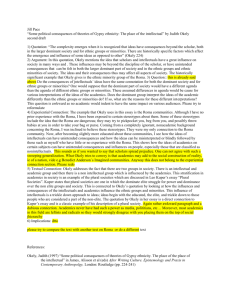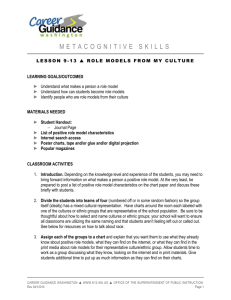Understanding Pedagogic Discrimination: Strategies for
advertisement
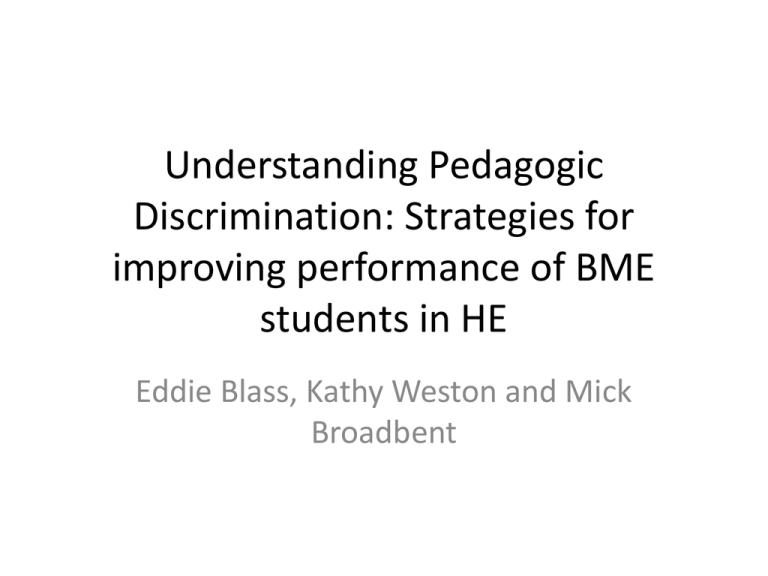
Understanding Pedagogic Discrimination: Strategies for improving performance of BME students in HE Eddie Blass, Kathy Weston and Mick Broadbent Context • The ‘idea’ of the university • White male upper class history • Shift to multicultural, international student body • Government target of 50% participation • Pressure to recruit overseas students for financial reasons • How has the provision changed in response? Case Study Context • Post-92 University • Approaching 50% non-white student population • Mirrors national picture of differential attainment rates by ethnicity • Typical in commitment to enhancing Teaching and Learning (ie CELT centre, enhancement awards, etc) • International student induction and accelerated skills unit • Mentoring schemes for any students who buy-in Methodology • Student focus groups specific to ethnicity • Staff focus groups • One-to-one interviews with high performing students within low performing categories • Analysis of teaching and learning methodologies • Seminar observations • Questionnaire (forthcoming) Baseline Position • Students will segregate themselves if we do not do something actively to encourage behaviour otherwise. – Loss of opportunity to extend base of knowledge – Loss of opportunity to improve language schools – Exclusive behaviour in the classroom – Differential grade outcomes – BUT safe and secure position for students to take Response of Academics • Four options: 1. Deny the situation and ignore it 2. Acknowledge the situation and accentuating it through classroom action 3. Acknowledge the situation and continue to ignore it, often due to lack of strategies to address the situation 4. Acknowledge the situation and seek out strategies to address the situation Example 1 • Lecturer finds the names of students from BME groups difficult to pronounce and hence avoids addressing those students by name in the class. • Intention is not to embarrass themselves or the students. • Implication is students are more excluded in the classroom. Example 2 • Groupwork assignments are set with random allocation of group members. • Intention is to integrate between groups of differing ethnicity. • Implication is that some students feel they are carrying others and resentment between ethnic groups increases. Example 3 • Lecturers select case study examples to illustrate theory from current newspaper or Western textbooks. • Intention is to bring the theory to life. • Implication is that organisations operating in non-Western cultures are excluded and nonWestern students are disadvantaged at contributing to the discussion. Student Response • Students are very positive about their experiences of teaching and learning in HE. • Students appear unaware of any indirect discriminatory practice. • There is no evidence of direct discrimination. • Students attribute underperformance to each other based on gender and specific ethnic groups, eg home Asian Males and overseas Chinese. Academics Response • Large amount of guilt experienced for not being able to redress the situation, particularly amongst women. • Some anger expressed at admissions procedures when English language clearly is not ‘good enough’. • Some evidence of staff stereotyping students to explain their levels of motivation and participation in seminars. Academic Responses • Academics do not know how to support international students and some express ambivalence as to whether or not they should. • Tailored support offered for disability but not for other sources of disadvantage. • Acknowledgement of cultural unawareness and reliance on stereotypes. • Insecurity surrounding the issues and hence a ‘whispering’ culture Suggestions for ways forward • Development of international case studies to situate the learning in a variety of ethnic contexts. • Greater use of peer assisted learning strategies to embed social relationships across ethnic groups. • Development of inclusive seminar teaching strategies amongst academics. • Greater use of technology to mediate language use. Are sessions podcastable? • Development of materials to support overseas students in the UK model of assessment, including samples and model answers to demonstrate differences between assessment questions. • Staff development to overcome stereotypes. On-going activity • Still consider this to be pilot work • Seeking funding for extension • Questionnaire being developed to test wider experiences • Possible extension to alumni Any Questions THANK YOU FOR LISTENING

